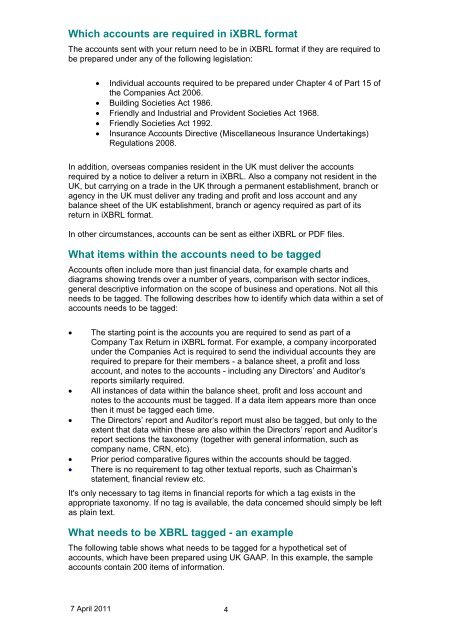XBRL - when to tag, how to tag, what to tag - HM Revenue & Customs
XBRL - when to tag, how to tag, what to tag - HM Revenue & Customs
XBRL - when to tag, how to tag, what to tag - HM Revenue & Customs
You also want an ePaper? Increase the reach of your titles
YUMPU automatically turns print PDFs into web optimized ePapers that Google loves.
Which accounts are required in i<strong>XBRL</strong> format<br />
The accounts sent with your return need <strong>to</strong> be in i<strong>XBRL</strong> format if they are required <strong>to</strong><br />
be prepared under any of the following legislation:<br />
7 April 2011<br />
� Individual accounts required <strong>to</strong> be prepared under Chapter 4 of Part 15 of<br />
the Companies Act 2006.<br />
� Building Societies Act 1986.<br />
� Friendly and Industrial and Provident Societies Act 1968.<br />
� Friendly Societies Act 1992.<br />
� Insurance Accounts Directive (Miscellaneous Insurance Undertakings)<br />
Regulations 2008.<br />
In addition, overseas companies resident in the UK must deliver the accounts<br />
required by a notice <strong>to</strong> deliver a return in i<strong>XBRL</strong>. Also a company not resident in the<br />
UK, but carrying on a trade in the UK through a permanent establishment, branch or<br />
agency in the UK must deliver any trading and profit and loss account and any<br />
balance sheet of the UK establishment, branch or agency required as part of its<br />
return in i<strong>XBRL</strong> format.<br />
In other circumstances, accounts can be sent as either i<strong>XBRL</strong> or PDF files.<br />
What items within the accounts need <strong>to</strong> be <strong>tag</strong>ged<br />
Accounts often include more than just financial data, for example charts and<br />
diagrams s<strong>how</strong>ing trends over a number of years, comparison with sec<strong>to</strong>r indices,<br />
general descriptive information on the scope of business and operations. Not all this<br />
needs <strong>to</strong> be <strong>tag</strong>ged. The following describes <strong>how</strong> <strong>to</strong> identify which data within a set of<br />
accounts needs <strong>to</strong> be <strong>tag</strong>ged:<br />
� The starting point is the accounts you are required <strong>to</strong> send as part of a<br />
Company Tax Return in i<strong>XBRL</strong> format. For example, a company incorporated<br />
under the Companies Act is required <strong>to</strong> send the individual accounts they are<br />
required <strong>to</strong> prepare for their members - a balance sheet, a profit and loss<br />
account, and notes <strong>to</strong> the accounts - including any Direc<strong>to</strong>rs’ and Audi<strong>to</strong>r’s<br />
reports similarly required.<br />
� All instances of data within the balance sheet, profit and loss account and<br />
notes <strong>to</strong> the accounts must be <strong>tag</strong>ged. If a data item appears more than once<br />
then it must be <strong>tag</strong>ged each time.<br />
� The Direc<strong>to</strong>rs’ report and Audi<strong>to</strong>r’s report must also be <strong>tag</strong>ged, but only <strong>to</strong> the<br />
extent that data within these are also within the Direc<strong>to</strong>rs’ report and Audi<strong>to</strong>r’s<br />
report sections the taxonomy (<strong>to</strong>gether with general information, such as<br />
company name, CRN, etc).<br />
� Prior period comparative figures within the accounts should be <strong>tag</strong>ged.<br />
� There is no requirement <strong>to</strong> <strong>tag</strong> other textual reports, such as Chairman’s<br />
statement, financial review etc.<br />
It's only necessary <strong>to</strong> <strong>tag</strong> items in financial reports for which a <strong>tag</strong> exists in the<br />
appropriate taxonomy. If no <strong>tag</strong> is available, the data concerned should simply be left<br />
as plain text.<br />
What needs <strong>to</strong> be <strong>XBRL</strong> <strong>tag</strong>ged - an example<br />
The following table s<strong>how</strong>s <strong>what</strong> needs <strong>to</strong> be <strong>tag</strong>ged for a hypothetical set of<br />
accounts, which have been prepared using UK GAAP. In this example, the sample<br />
accounts contain 200 items of information.<br />
4

















